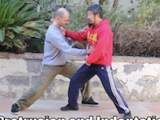 Many years ago when I was just learning Yilu, I had questions about how the “Second Closing” (the move after fetch water) was done properly. I was just imitating the movement, the hand was waving from one place to another place. I had no idea where was the energy alignment in that particular move. Master Chen explained “Second Closing” with its application and tried on me. He turned and I was on the ground. It was that simple. I didn’t know, I could not figure out how Master Chen did. But I did know how powerful the “Second Closing” was.
Many years ago when I was just learning Yilu, I had questions about how the “Second Closing” (the move after fetch water) was done properly. I was just imitating the movement, the hand was waving from one place to another place. I had no idea where was the energy alignment in that particular move. Master Chen explained “Second Closing” with its application and tried on me. He turned and I was on the ground. It was that simple. I didn’t know, I could not figure out how Master Chen did. But I did know how powerful the “Second Closing” was.
Watching “Second Closing” closely in Master Chen’s Yilu practice, Master Chen just flipped his left palm up when he set his right foot back and turned. Nothing fancy, nothing seemed special and powerful. I knew there was something in it that I didn’t understand and could not do. Meanwhile, I started to do “Second Closing” as if I was doing left side “Six Sealing Four Closing” plus rotation, and made sure that I pull the left elbow straight in while my body was turning.
Many years have passed, I could now effectively move opponents when I do “Six Sealing Four Closing.” The energy alignment seems right. Same as in “Second Closing.” When I do “Second Closing” in Yilu, I set the contact point (with an imaginary opponent) in the middle of left forearm. Set right foot back, turn, at same time, pull elbow in, the contact point is not powered, left hand stretch outwardly. Elbow and hand are as if twining around the contact point. The turning of the arm becomes spiral reeling due to the body rotation simultaneously.
Now, I try to do “Second Closing” in the way Master Chen showed us, I just move the imaginary contact point to my armpit, my hand and elbow are not moving, palm turned up while stepping back and turn, with the shoulder open, more power is produced. The outlook of “Second Closing” movement is smaller than that of “Six Sealing Four Closing.” The inside movement of “Second Closing” indeed is much larger than that of “Six Sealing Four Closing.” With correct execution, even a heavier opponent can be pulled with “Second Closing.”
Different contact points produce different effects. In fact, they are corresponding to different types of lever. “Second Closing” is like a hay cutter, which employs one type of lever. The longer the effort arm of the lever, less effort is needed in order to move a heavy load. However, our body is not like a stick. We have to understand the energy alignment in every move. Along the energy alignment we produce a straight line as if a stick inside of body. Only then we can apply the lever principle in our Tai Chi practice.
As illustrated in the figure, three types of lever A, B, and C, are different applications of a stick. In B and C applications, they correspond to Master Chen’s teaching, “Don’t move hand, move inside.” I just explained that for many years I used “Six Sealing Four Closing” in place where “Second Closing” really should be, because I really didn’t understand how to open the shoulder. In “Six Sealing Four Closing” withdrawing the elbow is relatively easier. As in B, the power applied to the opponent (load) is pointing up and outward. When the contact point move to armpit, with opening the shoulder, stepping back and rotating, the power is pointing in- and downward, as see in C.




